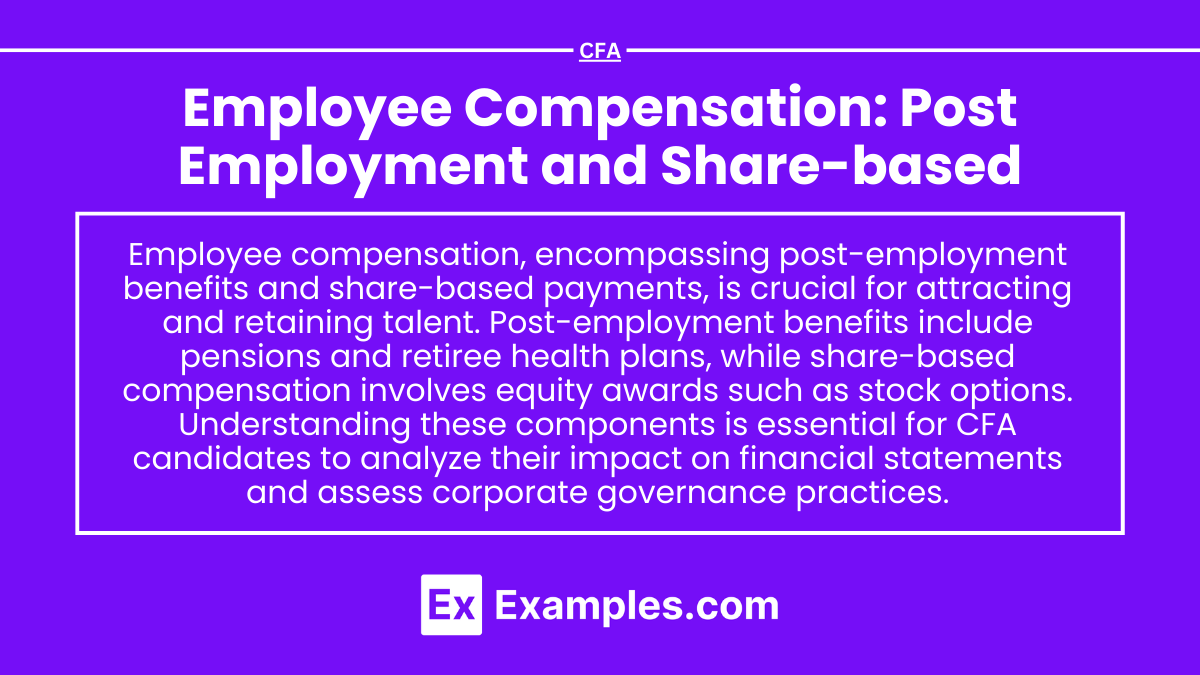Employee Compensation, focusing on Post-Employment and Share-Based plans, is essential for understanding long-term liabilities and expense recognition in financial statements. This topic covers the valuation, accounting, and reporting of post-employment benefits such as pensions and healthcare, along with share-based compensation structures like stock options and restricted shares. These components affect both income and equity, influencing a company’s financial position and performance metrics. A thorough grasp of these areas is critical for evaluating the impact of compensation plans on an organization’s financial health, making it a core aspect of financial analysis and valuation.
Learning Objectives
In studying “Employee Compensation: Post-Employment and Share-Based” for the CFA exam, you should learn to identify and understand the different types of post-employment benefits, including defined benefit and defined contribution plans, and analyze the financial implications of each on a company’s financial statements. Gain insight into actuarial assumptions and how they impact pension obligations and expense reporting. Understand the valuation and accounting treatment of share-based compensation, including stock options, restricted stock, and performance shares. Evaluate the impact of employee compensation on profitability and leverage ratios, and recognize how firms disclose these obligations in accordance with IFRS and U.S. GAAP. Additionally, develop the ability to assess the effect of post-employment and share-based compensation on a company’s financial health and investment attractiveness.
Types of Post-Employment Benefits
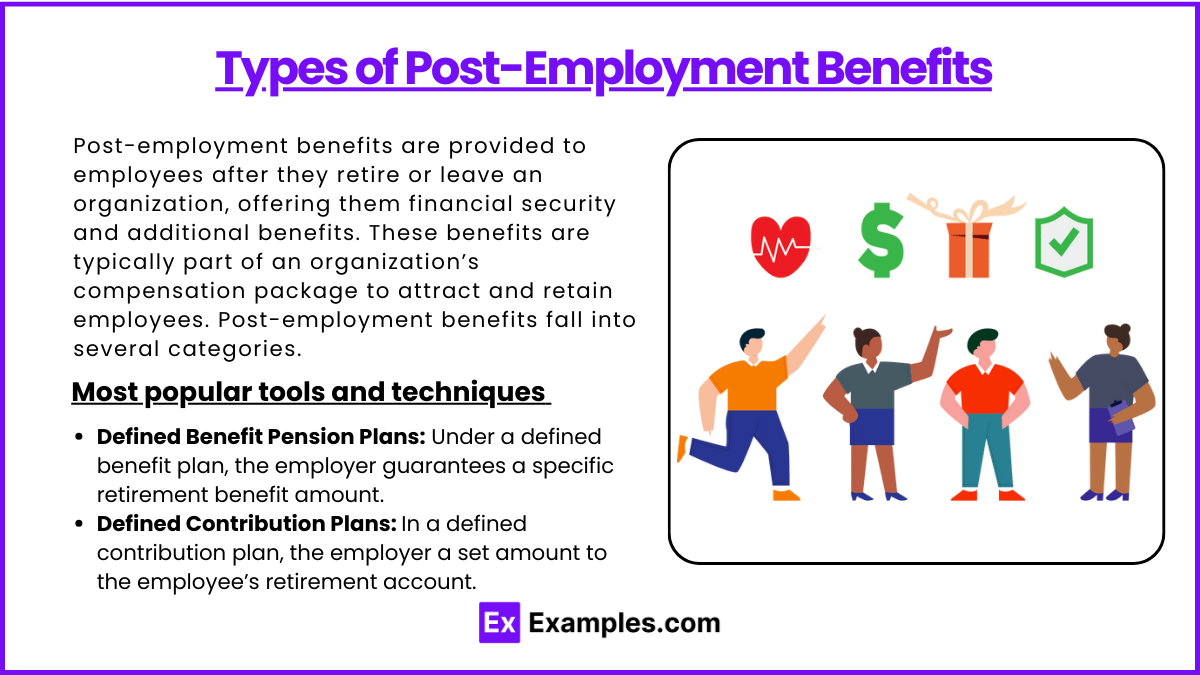
Post-employment benefits are provided to employees after they retire or leave an organization, offering them financial security and additional benefits. These benefits are typically part of an organization’s compensation package to attract and retain employees. Post-employment benefits fall into several categories, including pensions, health care benefits, life insurance, and other retirement benefits.
1. Defined Benefit Pension Plans
Under a defined benefit plan, the employer guarantees a specific retirement benefit amount based on factors such as the employee’s salary, age, and years of service. The employer bears the investment risk and is responsible for funding the plan to ensure the promised benefits are available upon retirement.
- Key Characteristics: The benefits are typically calculated based on a formula, such as a percentage of the employee’s final salary times years of service.
- Financial Impact on Employer: The employer must contribute enough to fund the defined benefits and must report pension liabilities if the plan is underfunded.
- Advantages for Employees: Employees receive a predictable retirement income, providing them with financial stability.
Example: An employer offers a pension benefit equal to 1.5% of the employee’s final salary for each year of service. An employee with 30 years of service and a final salary of $100,000 would receive $45,000 annually in retirement benefits (1.5% x $100,000 x 30 years).
2. Defined Contribution Plans
In a defined contribution plan, the employer and/or employee contribute a set amount to the employee’s retirement account during the employee’s working years. The retirement benefit depends on the total contributions made and the investment performance of those contributions. Unlike defined benefit plans, the employee bears the investment risk.
- Key Characteristics: The employer’s obligation is limited to the contributions made; there is no guaranteed benefit amount at retirement.
- Financial Impact on Employer: The employer’s cost is predictable, as it is limited to contributions rather than future benefit obligations.
- Advantages for Employees: Employees have control over the investment choices within the account, potentially allowing for higher returns.
Example: An employer contributes 5% of an employee’s annual salary into a retirement savings account. If the employee’s annual salary is $80,000, the employer contributes $4,000 each year.
Financial Implications of Post-Employment Benefits on Financial Statements
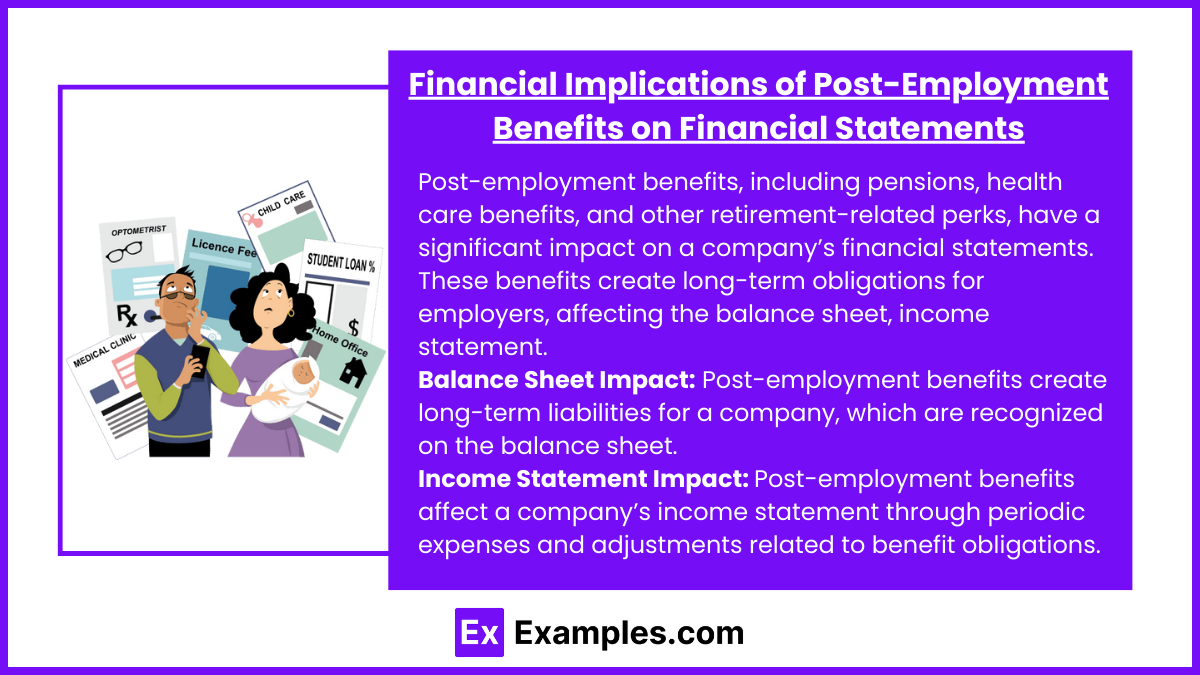
Post-employment benefits, including pensions, health care benefits, and other retirement-related perks, have a significant impact on a company’s financial statements. These benefits create long-term obligations for employers, affecting the balance sheet, income statement, and cash flow statement. Recognizing, measuring, and reporting these benefits accurately is essential for providing stakeholders with a realistic view of the company’s financial health.
1. Balance Sheet Impact
Post-employment benefits create long-term liabilities for a company, which are recognized on the balance sheet.
Defined Benefit Pension Plans
For defined benefit plans, employers recognize a pension liability on the balance sheet, reflecting the difference between the fair value of plan assets and the present value of projected benefit obligations (PBO).
- Net Pension Liability (or Asset): Calculated as the projected benefit obligation (PBO) minus the fair value of plan assets. If the PBO exceeds plan assets, the company has a net pension liability; if plan assets exceed the PBO, there is a net pension asset.
- Impact on Equity: Actuarial gains and losses, along with past service costs, may be recognized in other comprehensive income (OCI), affecting accumulated other comprehensive income (AOCI), a component of equity.
Example: If a company has a PBO of $10 million and plan assets of $8 million, it will report a net pension liability of $2 million on the balance sheet.
Post-Employment Health Care and Life Insurance Benefits
Similar to pensions, post-employment health care and life insurance benefits create long-term liabilities that must be measured and recognized.
- Accrued Post-Retirement Benefit Obligation (APBO): The estimated present value of expected future health care and life insurance benefits owed to retirees. This liability is recognized on the balance sheet, impacting overall liabilities.
- Inflation and Health Cost Assumptions: These obligations can be affected by rising health care costs, requiring adjustments to the liability balance.
Example: If a company projects $3 million in future health care benefits for retirees, this amount will be recorded as a liability, reducing equity and increasing long-term liabilities.
Defined Contribution Plans
For defined contribution plans, there is no long-term liability because the employer’s obligation is limited to the contributions it makes to employees’ retirement accounts each year.
- No Long-Term Liability: Contributions are recognized as an expense on the income statement as they are made, with no ongoing balance sheet liability.
- Simplified Reporting: This plan type results in fewer financial implications than defined benefit plans.
2. Income Statement Impact
Post-employment benefits affect a company’s income statement through periodic expenses and adjustments related to benefit obligations.
Defined Benefit Pension Plans
The total pension expense for defined benefit plans includes several components:
- Service Cost: The increase in the pension obligation due to employee service in the current period.
- Interest Cost: The cost of carrying the pension obligation, calculated as the present value of the projected benefit obligation times the discount rate.
- Expected Return on Plan Assets: A reduction in pension expense based on the expected return on invested pension assets.
- Amortization of Actuarial Gains or Losses: Actuarial gains or losses arise from changes in assumptions or differences between expected and actual plan performance. These amounts are typically amortized over time.
Example: If a company’s pension expense consists of a $1 million service cost, a $500,000 interest cost, and a $200,000 expected return on plan assets, the net pension expense recorded on the income statement would be $1.3 million ($1M + $500K – $200K).
Post-Employment Health Care and Life Insurance Benefits
These benefits create an annual expense similar to pensions, based on the estimated cost of providing post-employment health care or insurance coverage.
- Service and Interest Costs: Calculated similarly to pension plans, with service cost reflecting current employee benefits earned and interest cost reflecting the discounting of future benefit obligations.
- Amortization of Gains or Losses: Actuarial gains and losses from changes in health care cost assumptions or demographic factors are typically amortized over time, impacting net periodic post-retirement benefit expense.
Example: A company with a projected health care benefit obligation may record $200,000 in current service costs, $100,000 in interest cost, and a small amortization of prior losses, resulting in a total post-retirement health care expense of $310,000.
Defined Contribution Plans
For defined contribution plans, the expense is simply the amount of contributions made by the employer to the employee’s retirement account during the period.
- Straightforward Expense Recognition: The employer recognizes an expense based on the percentage or fixed amount contributed, with no long-term expense adjustments.
- Impact on Profitability: The contribution expense reduces net income but is predictable and does not fluctuate based on actuarial assumptions or investment returns.
Example: If a company contributes 5% of each employee’s salary to a defined contribution plan and has an annual payroll of $10 million, it records an annual contribution expense of $500,000.
Actuarial Assumptions and Their Impact on Pension Obligations
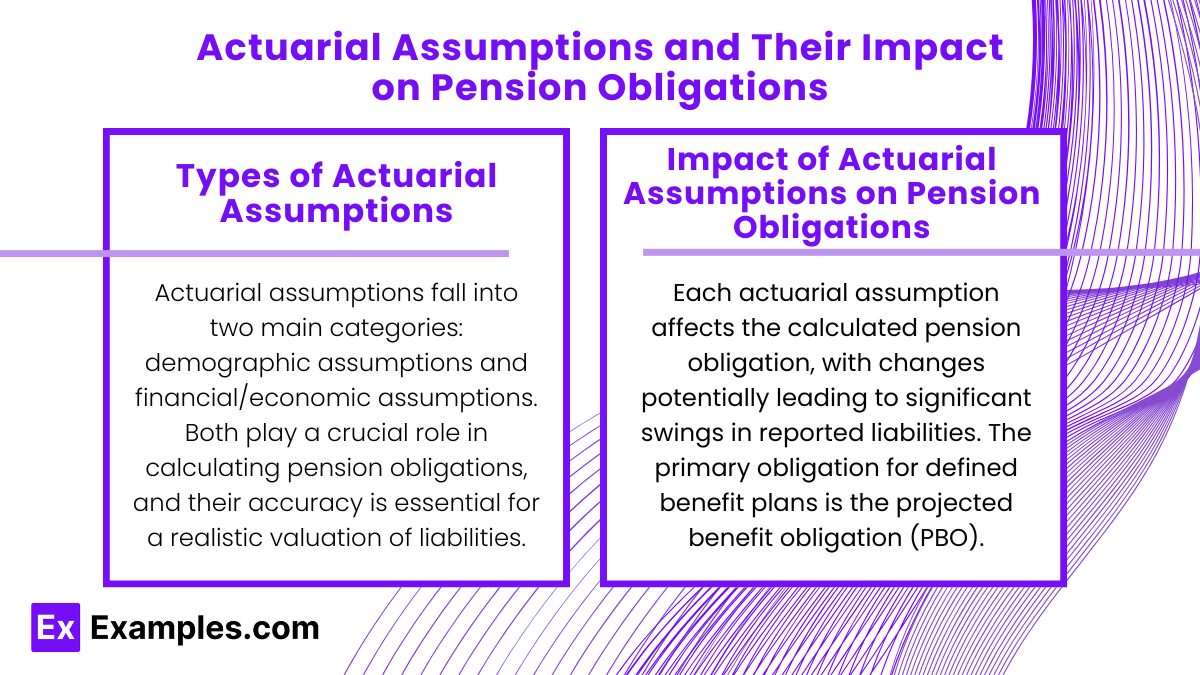
Actuarial assumptions are critical in determining the value of pension obligations, especially for defined benefit plans where the employer promises specific retirement benefits. These assumptions include factors like life expectancy, salary growth, and interest rates, which affect the present value of future pension payments. Small changes in these assumptions can have significant effects on pension liabilities and costs, impacting a company’s financial statements and overall financial health.
1. Types of Actuarial Assumptions
Actuarial assumptions fall into two main categories: demographic assumptions and financial/economic assumptions. Both play a crucial role in calculating pension obligations, and their accuracy is essential for a realistic valuation of liabilities.
Demographic Assumptions
- Mortality Rate: Assumptions about life expectancy estimate how long retirees will receive benefits. Longer life expectancy increases pension obligations, as payments extend over more years.
- Employee Turnover and Retirement Age: Turnover rates predict the number of employees who will stay until retirement and the expected retirement age. Higher turnover reduces pension obligations, as fewer employees will ultimately collect benefits. Conversely, early retirement options increase costs.
- Disability and Other Demographic Factors: Some plans include disability benefits or other demographic factors. Assumptions about these factors affect the expected payments required under the plan.
Financial/Economic Assumptions
- Discount Rate: The rate used to discount future pension payments to their present value. A higher discount rate reduces the present value of future obligations, while a lower rate increases it. The discount rate typically reflects long-term interest rates and economic conditions.
- Salary Growth Rate: For plans that calculate benefits based on final or average salary, the projected rate of salary growth affects the pension liability. Higher salary growth assumptions increase future pension payments and obligations.
- Expected Rate of Return on Plan Assets: This assumption reflects the anticipated return on invested pension assets. Although it does not affect the pension obligation directly, it influences the overall pension cost and the required employer contributions.
2. Impact of Actuarial Assumptions on Pension Obligations
Each actuarial assumption affects the calculated pension obligation, with changes potentially leading to significant swings in reported liabilities. The primary obligation for defined benefit plans is the projected benefit obligation (PBO), which reflects the present value of estimated future benefits owed to employees based on their expected years of service.
Mortality Rate and Longevity
- Longer Life Expectancy: Increases the projected duration of benefit payments, leading to a higher PBO. Companies must prepare for the financial impact of supporting retirees for longer periods.
- Mortality Rate Adjustments: If a mortality assumption is revised to reflect longer life expectancy, the PBO can increase significantly, adding to the employer’s liabilities.
Example: A plan assumes employees will live, on average, to age 85. If the assumption changes to 88, the additional years increase the total pension payments, leading to a higher PBO.
Employee Turnover and Retirement Age
- Higher Turnover Rates: Lower the PBO, as fewer employees are expected to remain until retirement age. Lower turnover has the opposite effect, increasing the PBO as more employees are anticipated to receive benefits.
- Early Retirement Trends: If employees retire earlier than anticipated, it can increase pension costs due to longer benefit periods and potentially larger payments if the plan includes early retirement incentives.
Example: A company anticipates a 5% turnover rate but revises it down to 3%, increasing the number of employees expected to qualify for benefits, thereby raising the PBO.
Discount Rate
- Higher Discount Rate: Lowers the PBO because future pension payments are discounted more steeply to their present value.
- Lower Discount Rate: Raises the PBO, as future payments are discounted less steeply, making the present value larger.
Example: If the discount rate is reduced from 5% to 4%, the present value of pension obligations rises, increasing the PBO and potentially causing the company to report higher liabilities on the balance sheet.
Salary Growth Rate
- Higher Salary Growth Assumption: Raises the PBO for plans based on final or average salary, as projected benefits will be higher.
- Lower Salary Growth Assumption: Reduces the PBO, reflecting lower anticipated benefits due to slower salary growth.
Example: If a plan’s benefits are based on final salary and the salary growth rate assumption increases from 3% to 4%, future pension obligations will rise as projected final salaries are now expected to be higher.
Expected Rate of Return on Plan Assets
The expected rate of return on plan assets affects pension expense, not the PBO directly, but it has a significant impact on funding requirements and overall pension cost.
- Higher Expected Return: Reduces pension expense by offsetting a larger portion of the cost with anticipated asset earnings, lowering the need for employer contributions.
- Lower Expected Return: Increases pension expense, as lower expected asset earnings mean the company may need to contribute more to meet future obligations.
Example: If the expected rate of return on plan assets is lowered from 7% to 6%, the annual pension expense increases as the company may need to contribute more to offset lower expected investment earnings.
Valuation and Accounting Treatment of Share-Based Compensation
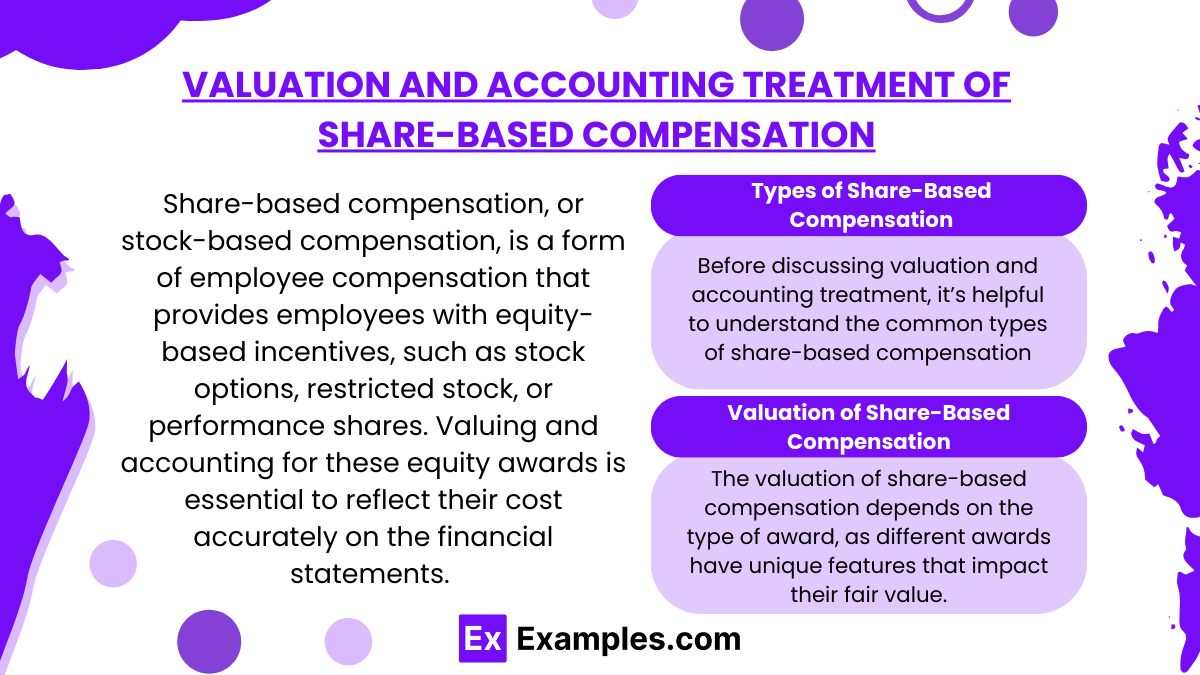
Share-based compensation, or stock-based compensation, is a form of employee compensation that provides employees with equity-based incentives, such as stock options, restricted stock, or performance shares. Valuing and accounting for these equity awards is essential to reflect their cost accurately on the financial statements. The accounting treatment is governed by standards like ASC 718 (U.S. GAAP) and IFRS 2, ensuring that companies recognize the fair value of share-based compensation over the period in which employees provide service.
1. Types of Share-Based Compensation
Before discussing valuation and accounting treatment, it’s helpful to understand the common types of share-based compensation:
- Stock Options: Employees have the right to purchase company stock at a specified price (exercise or strike price) after a vesting period.
- Restricted Stock: Shares are granted to employees but are subject to restrictions, such as a vesting period or performance conditions.
- Performance Shares: Shares are awarded based on achieving specific performance targets, such as revenue growth or earnings targets.
- Employee Stock Purchase Plans (ESPPs): Plans allowing employees to purchase company stock at a discount, often with certain restrictions on resale.
2. Valuation of Share-Based Compensation
The valuation of share-based compensation depends on the type of award, as different awards have unique features that impact their fair value.
Valuation of Stock Options
Stock options are typically valued using an option pricing model, such as the Black-Scholes model or a binomial model. These models take into account various factors that influence the option’s value:
- Exercise Price: The price at which employees can purchase the stock, which affects the option’s intrinsic value.
- Stock Price: The current price of the underlying stock.
- Expected Life of the Option: The estimated period over which the employee will hold the option before exercising.
- Volatility: The expected fluctuation in the stock’s price, with higher volatility increasing the option’s fair value.
- Risk-Free Rate: The risk-free interest rate for the option’s expected life, typically based on government bond yields.
- Dividend Yield: The expected dividend yield on the underlying stock, which reduces the option’s fair value.
Example: A company grants stock options with an exercise price of $50, a current stock price of $60, an expected life of 5 years, 30% stock price volatility, a 1.5% risk-free rate, and a 2% dividend yield. These factors are input into the Black-Scholes model to calculate the fair value per option.
Examples
Example 1: Defined Benefit Pension Plans
A defined benefit pension plan provides employees with a guaranteed payout upon retirement, based on their salary and years of service. For instance, a company may offer a pension plan that pays employees 60% of their final average salary after 30 years of service. This post-employment benefit ensures financial security for employees during retirement, reflecting the company’s commitment to their long-term welfare.
Example 2: Defined Contribution Retirement Plans
In a defined contribution plan, such as a 401(k), both employees and employers contribute to an individual account set up for the employee. The final benefit received at retirement depends on the total contributions and investment performance. For example, a company might match employee contributions up to a certain percentage, incentivizing employees to save for their retirement while fostering a sense of ownership over their financial future.
Example 3: Stock Options
Stock options give employees the right to purchase company shares at a predetermined price after a specified period. For instance, a tech company may offer its employees stock options that allow them to buy shares at $50, even if the market price rises to $80. This share-based compensation aligns employee interests with shareholders, as employees benefit directly from increases in the company’s stock price.
Example 4: Restricted Stock Units (RSUs)
RSUs are a form of equity compensation that grants employees shares of stock upon the completion of certain conditions, such as remaining with the company for a specific time frame. For example, a corporation may grant RSUs to employees that vest over four years, incentivizing retention and long-term performance. Once vested, the employees receive shares that can appreciate in value, contributing to their overall compensation.
Example 5: Post-Employment Health Benefits
Companies may offer post-employment health benefits, such as retiree health insurance or health reimbursement accounts. For example, a manufacturing firm may provide health insurance coverage to employees who retire after 20 years of service. This benefit enhances the overall compensation package and supports employees’ health care needs in retirement, reflecting the organization’s commitment to their long-term well-being.
Practice Questions
Question 1
Which of the following is considered a post-employment benefit?
A) Stock options
B) Pension plans
C) Annual bonuses
D) Performance incentives
Correct Answer: B) Pension plans.
Explanation: Pension plans are a type of post-employment benefit designed to provide income to employees after they retire. They are typically funded during the employee’s working years and paid out after retirement. In contrast, stock options, annual bonuses, and performance incentives are forms of compensation that are typically awarded during an employee’s tenure, not after employment has ended.
Question 2
What is the main purpose of share-based compensation for employees?
A) To enhance short-term liquidity for the company
B) To align employee interests with those of shareholders
C) To minimize payroll taxes
D) To provide guaranteed income regardless of performance
Correct Answer: B) To align employee interests with those of shareholders.
Explanation: Share-based compensation, such as stock options or restricted stock units, is designed to align the interests of employees with those of the shareholders. When employees hold equity in the company, they are incentivized to work towards increasing the company’s value, as this will directly impact their own financial benefit. Options A, C, and D do not accurately describe the primary purpose of share-based compensation.
Question 3
Which of the following statements is true regarding the accounting for share-based payments?
A) Share-based payments are recorded as expenses only when the employee exercises their options.
B) The fair value of share-based payments is determined at the grant date.
C) Only stock options are subject to accounting standards for share-based payments.
D) Share-based payments have no impact on a company’s income statement.
Correct Answer: B) The fair value of share-based payments is determined at the grant date.
Explanation: According to accounting standards, the fair value of share-based payments is calculated at the grant date and recognized as an expense over the vesting period. This approach ensures that the costs associated with providing share-based compensation are appropriately matched with the performance benefits derived from the employees’ services. Option A is incorrect because expenses are recorded during the vesting period, not just at exercise. Option C is misleading, as all forms of share-based payments, not just stock options, are subject to accounting standards. Option D is also incorrect because share-based payments do affect the income statement as they are recognized as expenses.

